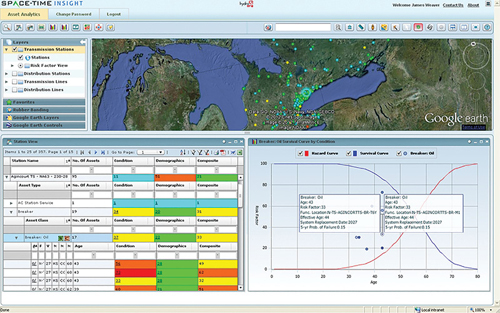
The Asset Analytics screen from Space-Time Insight’s situational-intelligence software lets operators assess grid performance, analyzing and correlating millions of data points from multiple sources. The upper window provides a geographic view of the service region and shortly after the passage of a severe storm. The dots tell of trouble spots while the lower windows tell more of the equipment at those locations.
Identifying grid outages is one of the more challenging problems utility companies face. Severe storms alone leave costly outages in their wakes while major events, such as hurricanes and tornadoes, produce long-term outages that cost billions in revenues and repairs.
A recent 10-day outage, for instance, cost one utility company more than $138 million, says Steven Ehrlich, Vice President with software developer Space-Time Insight (www.spacetimeinsight.com). Ehrlich in an interview says the software his company produces provides situational awareness or intelligence to monitor storm impacts and quickly identify outages. This situational intelligence helps reduce costs by visualizing the failure rate of assets over time and triggers the guidance to replace them or modify their maintenance plans.
The company says the software is ideal for monitoring wind-farm outages because it analyzes and correlates millions of data points from multiple sources which let utilities visually assess the performance of their electric grid on large screens. This monitoring is a critical requirement in the deployment of Wide Area Situational Awareness systems for smart grids.
The software also accommodates microsecond measurements recorded by synchrophasors, devices used to measure the state and quality of a power system sixty times a second. What’s more, the software provides control room operators with timely information needed to make instant decisions that impact grid stability and availability.

After severe weather, the situational-intelligence software provides utilities with information in pictures and graphs to rapidly repair outages.
Once a storm passes, grid data pours in to a control center. “Space-Time Insight’s situational intelligence helps utilities manage the data onslaught and make more rapid, intelligent decisions,” says Ehrlich. Operators can identify operational problems or situations, color-coded for system status, point to them, and then electronically direct their crews to quickly fix the problem. “Geospatial displays used with more traditional analytics are at the center of this information revolution because they provide a framework for visualization as well as a jumping-off point for further analysis and action,” says Ehrlich.
Knowing the status of the grid makes practical sense and gives utilities a head start on restoration. “By understanding a situation in real-time and reacting to it even a few minutes sooner than previously possible lets utilities save lives and property,” he adds.
As more smart devices and property are added to the smart grid, the need for situational intelligence becomes more critical. Ehrlich says proper situational intelligence improves a company’s ability to anticipate and prioritize service restoration, and assess the situation faster. These lead to a more collaborative response which reduces risk, duration, and cost of outages. Lastly, situational intelligences leverages the existing IT investment, lowers operating and planning costs, thereby producing a more resilient system. WPE
Filed Under: Featured, News, Software




